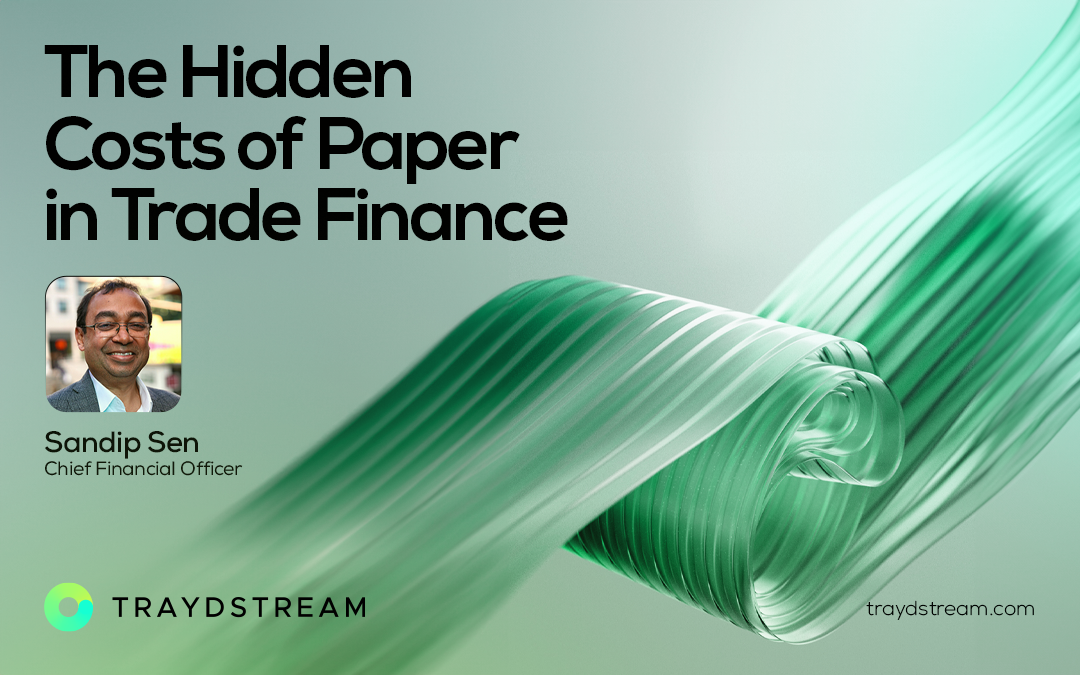
Every year, the global trade finance industry consumes enough paper to stretch from London to Beijing—and that’s just the start of the problem.
At first glance, paper might seem like a minor operational expense, but beneath the surface lies a web of hidden costs that drain resources, slow down processes, and expose institutions to unnecessary risks.
The Financial Drain You Don’t See
While the direct costs of paper—printing, storage, and courier fees—are evident, the indirect costs are far more substantial. Consider this:
Operational Inefficiencies: Manual document handling increases processing times, leading to delays in transactions. In trade finance, where speed can make or break deals, these delays translate to lost opportunities. For example, processing a Letter of Credit (LC) manually can take 5-10 business days, trending down from days to hours and now minutes with full digitization of workflows. Delays in document checking can lead to demurrage charges in shipping, increasing costs significantly. In one case, a major European bank reported losing over $500,000 annually due to demurrage fees linked to slow document processing.
Error Rates: Human errors in data entry and manual checks can lead to compliance breaches, costly fines, and reputational damage. A study by the International Chamber of Commerce (ICC) found that up to 70% of trade documents presented in traditional formats contain discrepancies. For example, mismatched invoice numbers or incorrect shipment dates often slip through unnoticed until they escalate into disputes, requiring extensive time and resources to resolve.
Labour Costs: Skilled professionals spend countless hours on mundane tasks like verifying documents, time that could be redirected towards strategic activities. Consider a compliance officer at a multinational bank who spends up to 60% of their time reviewing documents manually, reducing their capacity to focus on high-risk transactions and strategic risk assessments. The opportunity cost here is significant, both in terms of productivity and missed business opportunities.
“The financial implications of paper-based trade finance extend beyond operational inefficiencies. The cumulative costs of delayed transactions, compliance risks, and manual labour can erode profit margins significantly. Digitisation isn’t just an operational upgrade; it’s a strategic investment that optimises working capital, reduces risk exposure, and delivers measurable cost savings.” — Sandip Sen, Chief Finance Officer, Traydstream
The Compliance Risk Factor#
Beyond financial costs, paper-based processes pose significant compliance risks. TradeBased Money Laundering (TBML) often thrives in environments where manual document checks are the norm. Physical documents are easier to tamper with, and red flags can be overlooked amidst piles of paperwork.
Consider the case of a fraudulent invoice scheme uncovered in Southeast Asia, where criminals manipulated shipping documents to overstate the value of goods, laundering millions of dollars undetected for years. In a manual review process, discrepancies between invoices, packing lists, and shipping documents were subtle and consistently missed. Digital solutions like Traydstream’s AI-powered platform automatically crossverify data points across multiple documents, flagging inconsistencies in real-time and reducing the likelihood of such fraud slipping through the cracks.
A Case for Digital Transformation
Digitisation isn’t just about going paperless; it’s about creating resilient, efficient, and compliant operations. Solutions like Traydstream’s automated document checking system reduce processing times, minimise errors, and strengthen compliance frameworks—all while cutting costs.
Data Extraction and Validation: Traydstream uses advanced OCR (Optical Character Recognition) and NLP (Natural Language Processing) technologies to extract data from trade documents with over 95% accuracy. This data is then validated against predefined rules, regulatory requirements, and internal compliance checks, significantly reducing human error.
Real-Time Risk Detection: The system continuously monitors transactions for potential risks, such as sanctions breaches, dual-use goods, and suspicious trading patterns, providing alerts in real-time. For instance, if an invoice lists goods that are commonly used in TBML schemes, the system automatically flags it for further review.
Scalability and Integration: Traydstream’s platform seamlessly integrates with existing banking systems, enabling institutions to scale their operations without disrupting current workflows. This flexibility ensures that digital transformation supports business growth rather than hindering it.
The Bottom Line
Paper may seem cheap, but its hidden costs add up quickly. From operational delays and compliance risks to environmental impacts, the true cost of paper is far greater than it appears. Imagine a world where trade documents are processed in hours, not days—where compliance risks are flagged before they become threats. That world isn’t the future; it’s now.
Ready to uncover the hidden savings in your trade operations? Discover how Traydstream can help.

